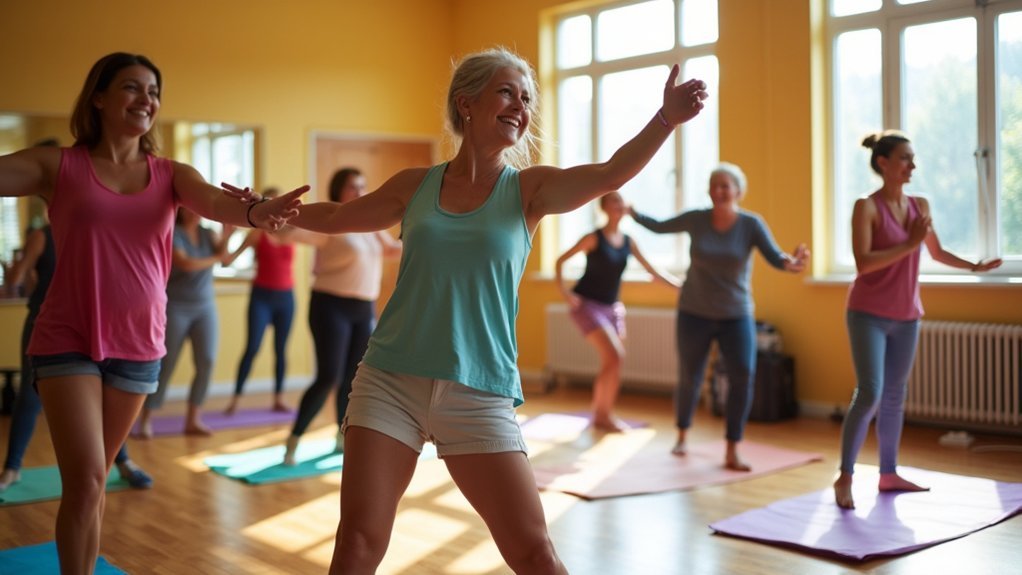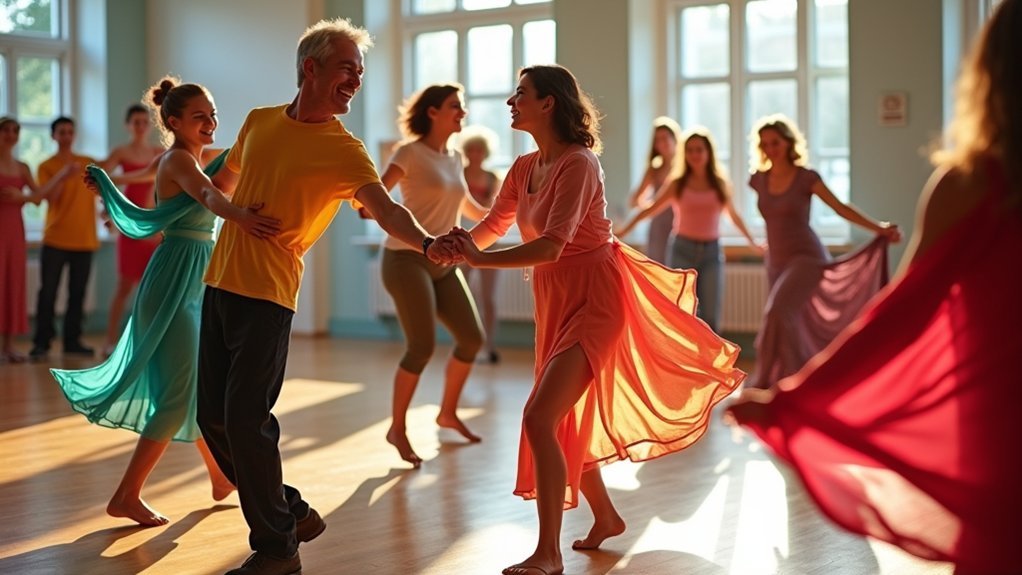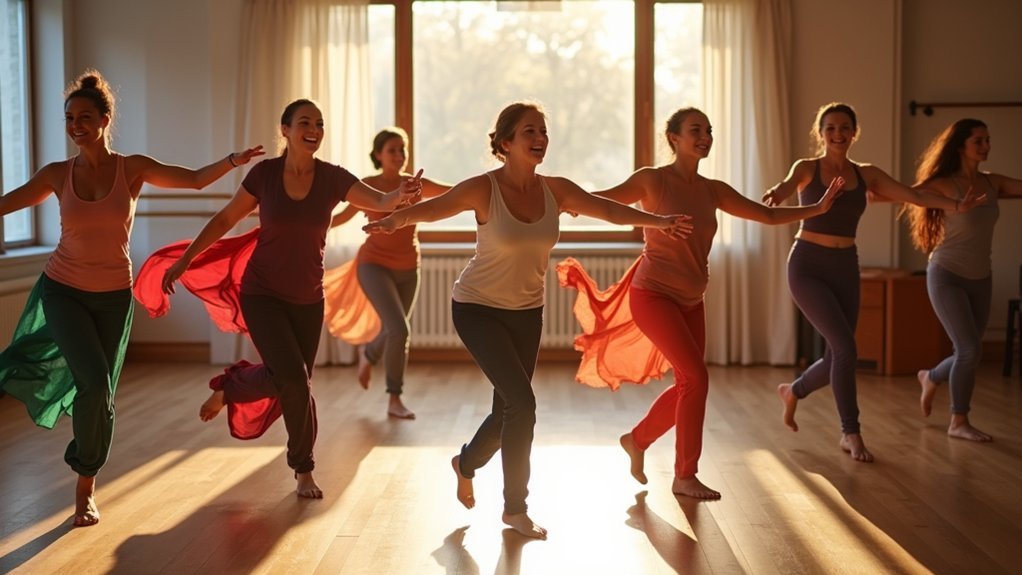Dance therapy offers you multiple benefits if you’re living with MS. It improves physical function through enhanced strength, balance, and coordination while reducing fall risk. You’ll likely experience decreased anxiety and depression as movement triggers mood-enhancing neurotransmitters. Dance programs—including wheelchair-adaptive styles—build essential social connections through partnered activities. Whether you choose group or solo formats, the combination of rhythmic movement, music, and community support creates a powerful approach to managing your MS symptoms. Discover how different dance styles can be tailored to your specific needs.
The Physical Benefits of Dance for MS Symptom Management

While managing symptoms of multiple sclerosis often requires a multifaceted approach, dance therapy has emerged as a promising physical intervention for many patients. Research shows that participating in structured dance sessions for 4-12 weeks can markedly improve your physical functioning with minimal adverse effects.
You’ll notice improvements in multiple areas: enhanced muscle strength as dance engages various muscle groups, increased endurance through regular practice, and better coordination by synchronizing movements to rhythm.
Line dancing and ballroom dancing specifically help improve your balance, potentially reducing fall risk. Recent research demonstrates that line dancing leads to significant improvements in balance for MS patients compared to control groups.
Dance therapy also offers a practical way to combat fatigue and sedentary behaviors common with MS. The activity can be tailored to your abilities, allowing you to increase participation gradually while building physical resilience through enjoyable, sustainable exercise.
Emotional Regulation and Mental Health Through Movement
Beyond the physical benefits, dance therapy offers powerful support for your emotional well-being when living with MS. Through rhythmic movement, you’ll engage in a natural form of emotional expression that reduces anxiety and depression while elevating positive mood states.
Dance therapy integrates cognitive, physical, and emotional aspects of your experience, helping you process feelings nonverbally when words feel inadequate. The repetitive, rhythmic movements trigger beneficial neurotransmitter release while choreography challenges cognitive control mechanisms tied to emotional regulation. Recent research shows cognitive functions improved after 12 weeks of dance classes for MS patients, as evidenced by enhanced TMT-B test results.
In group settings, you’ll experience emotional synchrony with others, reducing isolation while building social bonds. The mindfulness required during dance counteracts depressive rumination, while the mastery of new movements boosts self-efficacy and resilience—all essential protective factors for your mental health journey with MS.
Building Social Connections Through Partnered Dance

Partnered dance offers a powerful pathway to meaningful social connections when living with MS. When you join others in ballroom or line dancing, you’re engaging in activities that naturally foster communication and bonding. The shared experience creates vulnerability and trust among participants, deepening relationships through movement. The structured movements create predictable routines that can help you regain a sense of control over your body.
You’ll find that dancing with partners creates an emotional support network that’s particularly beneficial for coping with chronic conditions. The inclusive environment welcomes participants of all abilities, with many studios offering adaptive techniques for various physical limitations.
As you interpret signals from your partner and make quick decisions, you’re also improving cognitive functions while building community through shared experiences. This combination of physical activity and social interaction creates a holistic approach to wellness.
Wheelchair-Adaptive Dance Styles and Techniques
Wheelchair ballroom dancing offers you specialized techniques that transform traditional partner movements into accessible routines through synchronized wheelchair turns and adapted frame positions.
In sitting salsa, you’ll learn to create dynamic rhythmic patterns using upper body isolations and wheelchair mobility that captures the essence of Latin dance.
These adaptive styles maintain the core elements of each dance form while providing you with modified techniques that emphasize expression through arm styling, posture, and coordinated chair movements. This approach serves as a form of therapy while still being an enjoyable activity that allows participants to explore their abilities in new ways.
Wheelchair Ballroom Basics
Four foundational dance styles have been successfully adapted for wheelchair dancers: rumba, foxtrot, waltz, and tango. These adaptations transform your wheelchair into an extension of your body, creating fluid artistic expression through specialized movement techniques.
You’ll learn modified movements that emphasize upper body and arm gestures while mastering wheelchair control for turns, spins, and slides. These techniques simulate traditional ballroom flow while accommodating your seated position. Your instructor will tailor movements to your specific capabilities, focusing on what you can do rather than limitations. Similar to physically integrated dance, this approach challenges traditional perceptions of what dance should look like.
Partner connections rely on synchronized timing and coordinated maneuvers, using adapted holds and upper body contact points. Through practice, you’ll develop improved propulsion skills, learning to navigate space rhythmically while maintaining the elegant essence of ballroom dancing.
Sitting Salsa Techniques
Vibrant sitting salsa transforms traditional Latin dance into an accessible art form where you’ll express rhythm and passion from a seated position.
This adaptive style emphasizes upper body movements, with choreography flowing from your shoulders, arms, and torso.
You’ll develop modified spins and turns that accommodate wheelchair positioning, using clear tactile and verbal cues to coordinate with your partner.
Proper spinal alignment and core engagement will help you maintain balance and lead clarity.
As you practice, you’ll gain physical benefits including improved strength and flexibility, while enhancing coordination and memory.
The collaborative nature of sitting salsa builds confidence and fosters social connection.
Classes welcome both wheelchair users and ambulatory dancers, creating an inclusive environment where personalized instruction helps you discover comfortable, effective movements tailored to your abilities.
The dance style’s quick tempo and intensity provides an energizing experience that elevates mood while maintaining its Latin cultural roots.
How Dance Therapy Improves MS Mobility and Balance

Recent research reveals that dance therapy offers profound benefits for mobility and balance in multiple sclerosis patients. You’ll experience improved gait speed, walking endurance, and reduced risk of falls through regular dance participation. The multisensory integration of movement, music, and visual cues maximizes your body’s ability to adapt and respond to balance challenges. Various dance styles similar to those used with cerebral palsy patients can enhance brain plasticity through dynamic environments.
| Benefit | Measurement | Result |
|---|---|---|
| Gait Speed | Timed Up and Go Test | Significant improvement |
| Balance | Balance Confidence Scale | Reduced fall risk |
| Endurance | 6-minute walk test | Increased distance |
| Fatigue | Self-reported symptoms | Notable reduction |
Dance therapy engages your brain through sequencing, memory recall, and directional changes—promoting neuroplasticity while being enjoyable and sustainable compared to traditional exercises.
Selecting the Right Dance Program for Your MS Journey
When selecting a dance program for MS, you’ll want to match your mobility level with appropriate dance styles that can be adapted to your specific needs.
Consider whether social dance formats like ballroom or line dancing appeal to you, or if you’d prefer the therapeutic approach of dance-movement therapy with individual attention.
Your choice between group or partner-based dancing versus more solo-focused options will depend on your comfort with social interaction and whether you benefit from the added support of others during physical activity.
Research shows that partnered ballroom dance can provide crucial assistance with balance and stability while dancing, making it an excellent option for those experiencing postural instability.
Assessing Mobility Requirements
Before starting a dance therapy journey, you’ll need to accurately assess your current mobility level to find the most suitable program for your MS needs.
Consider working with your healthcare provider to evaluate your balance, gait, and endurance using tools like the Timed Up and Go Test or MS Walking Scale.
- Match dance styles to your functional abilities—salsa and ballet show promising results for mild to moderate MS.
- Look for programs incorporating multisensory stimuli to enhance your motor learning.
- Consider virtual classes if you have limited mobility or transportation challenges.
- Guarantee the program includes appropriate rest periods to manage fatigue.
- Select instructors trained in MS-specific movement adaptations who can offer seated options when needed.
Regular reassessment will help track your progress and adjust your dance program as your mobility changes. Weekly programs like the virtual dance class provide consistency with accessible movement options through both seated and standing exercises.
Dance Style Considerations
Choosing the right dance style for your MS needs can greatly impact your therapeutic outcomes and enjoyment. Consider options that emphasize improved motor function and coordination, which are proven benefits for MS patients.
If you’re experiencing mobility challenges, seated dance programs offer excellent accessibility while still providing rhythmic movement benefits. For those with more stability, gentle ballroom dancing or adapted ballet can enhance posture and balance.
Look for programs with instructors experienced in working with neurological conditions who can modify movements based on your energy levels and symptom fluctuations. Many dance therapy programs feature user-friendly interfaces that make tracking your progress and joining sessions simple.
The ideal dance style should challenge you appropriately without causing fatigue or overexertion.
Remember that the best dance therapy isn’t necessarily the most physically demanding—it’s the one you’ll consistently participate in because you find it engaging and enjoyable.
Group vs. Solo
Deciding between group and solo dance therapy presents a significant choice in your MS management journey. Each format offers unique benefits tailored to different needs and preferences.
Group sessions foster social connections and motivation through collective encouragement, while solo practices provide personalized approaches that accommodate fluctuating symptoms.
- Physical benefits: Group dance enhances endurance and sustained movement; solo allows targeted work on specific deficits
- Psychological impact: Groups reduce isolation and build community; solo sessions promote self-awareness and autonomy
- Practical factors: Consider your mobility limitations, transportation access, and schedule flexibility
- Symptom variability: Solo programs better accommodate unpredictable symptom flares
- Personal preference: Your comfort with social interaction versus private practice matters
Personal Stories: Transformative Effects of Dance on MS Patients
Three compelling narratives emerge from the personal accounts of MS patients who’ve embraced dance therapy.
First, physical transformations: “I can feel my strength returning,” many report, noting improved balance, coordination, and walking ability with minimal adverse effects.
Second, emotional rebirth: You’ll hear repeatedly how dance provides emotional regulation and freedom that traditional therapies lack. Patients describe significant reductions in depression and anxiety, replaced by newfound confidence and artistic fulfillment.
Finally, social reconnection: “I’ve found my community,” participants often share. Through partnered and group dance, you’ll discover networks of support that combat isolation. The shared creative experience fosters deep bonds among participants, creating lasting relationships that extend beyond the dance floor.
Frequently Asked Questions
Is Dance Therapy Covered by Insurance for MS Patients?
Dance therapy for MS isn’t universally covered by insurance. You’ll need a doctor’s prescription, prior authorization, and it’s often only covered when integrated into physical therapy plans. Check your specific policy details.
How Does Dance Compare to Traditional Physical Therapy for MS?
Dance offers you rhythmic, enjoyable movements enhancing coordination with emotional and social benefits, while traditional PT uses structured exercises focusing primarily on physical strength. Both improve function, but dance adds creative expression and community engagement.
Can Dance Therapy Reduce the Need for MS Medications?
Dance therapy may reduce your need for certain MS medications by improving symptoms naturally. You’ll find it can manage pain, fatigue, and mood issues while complementing your medical treatment plan. Research continues in this area.
Are There Virtual Dance Therapy Options for Homebound MS Patients?
Yes, you can access virtual dance therapy through online platforms, VR programs, and telehealth services that offer MS-adapted dance classes. These remote options provide supervised movement therapy with social benefits while accommodating your mobility limitations.
What Qualifications Should I Look for in an MS Dance Therapist?
Look for a therapist with an R-DMT or BC-DMT credential from an ADTA-approved program, experience working with MS patients, and knowledge of adaptive techniques. They should understand both movement principles and MS-specific challenges.
In Summary
Dance therapy offers you a holistic approach to managing your MS journey. You’ll gain physical benefits like improved balance and flexibility while experiencing emotional healing through expressive movement. Whether you’re dancing from a wheelchair or standing, you’re strengthening both your body and social connections. Don’t wait to experience the transformative effects—find a program that matches your abilities and start moving to reclaim control of your body.





Leave a Reply